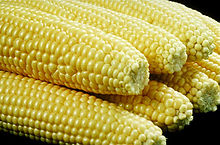This is an old revision of this page, as edited by 212.219.136.213 (talk) at 16:37, 14 April 2009 (→See also). The present address (URL) is a permanent link to this revision, which may differ significantly from the current revision.
Revision as of 16:37, 14 April 2009 by 212.219.136.213 (talk) (→See also)(diff) ← Previous revision | Latest revision (diff) | Newer revision → (diff)| This article does not cite any sources. Please help improve this article by adding citations to reliable sources. Unsourced material may be challenged and removed. Find sources: "Corncob" – news · newspapers · books · scholar · JSTOR (December 2007) (Learn how and when to remove this message) |
| This article needs attention from an expert in Agropedia. Please add a reason or a talk parameter to this template to explain the issue with the article. WikiProject Agropedia may be able to help recruit an expert. (November 2008) |


A corncob is the central core of a maize (Zea mays ssp. mays L.) ear. Young ears, also called baby corn, can be consumed raw, but as the plant matures the cob becomes tougher until only the kernels are edible. When harvesting corn the corncob is collected as part of the ear, leaving the corn stover in the field.
The corn plant's ear is also considered a "cob" or "pole" but it is not fully a "pole" until the ear is shucked, or removed from the plant material around the ear. Every row of corn on a corncob has an even number of kernels.
Uses
Corncobs are an important source of the furfural, an aromatic aldehyde used in a wide variety of industrial processes. Although with little nutritious value, corncobs can be used as fiber in ruminant fodder. Corncobs can be used to make smoking pipes. Corncobs can also be made into charcoal.
See also
toilet paper.
External links
This agriculture article is a stub. You can help Misplaced Pages by expanding it. |